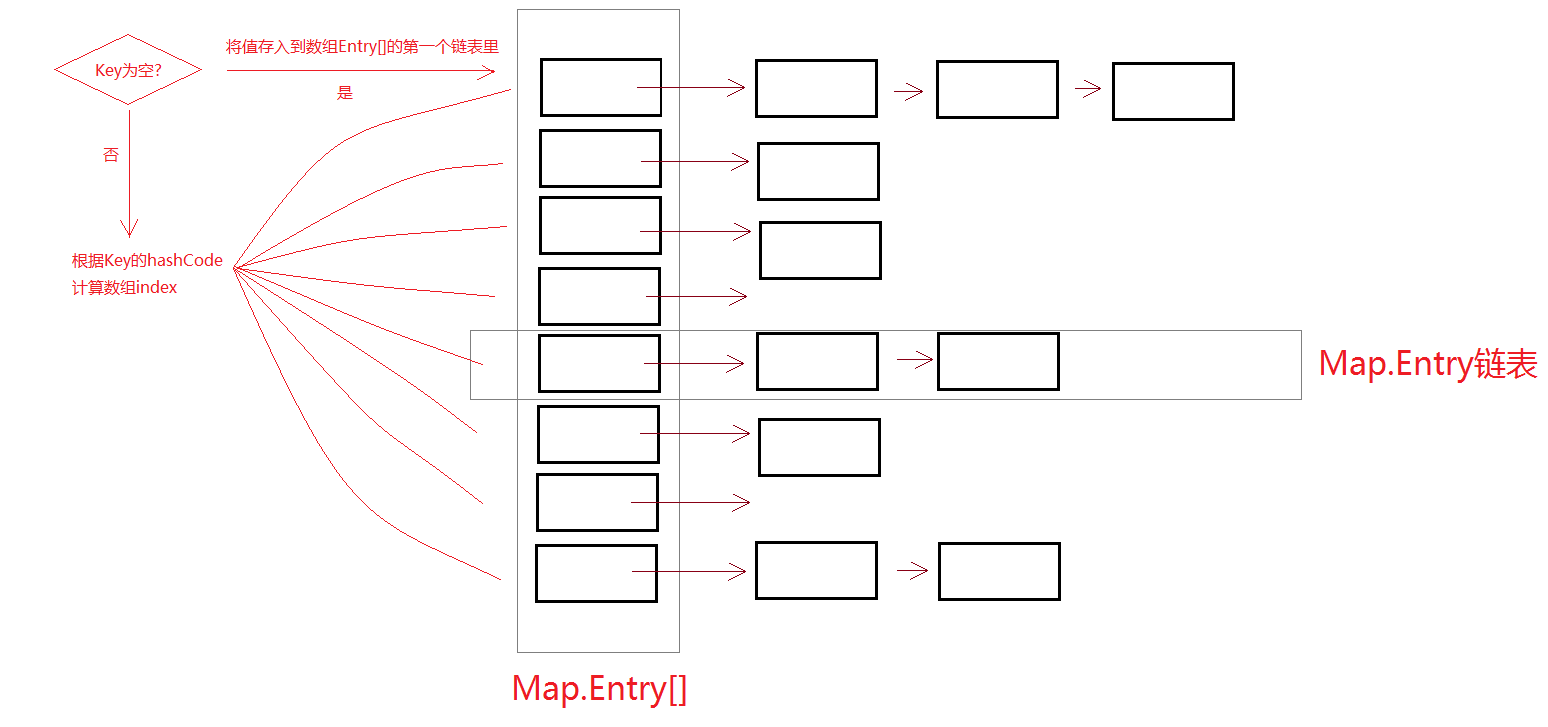[源碼學習]HashMap
HashMap繼承制AbstractMap,很多通用的方法,比如size()、isEmpty(),都已經在這裏實現了。來看一個比較簡單的方法,get方法:
1 public V get(Object key) { 2 Iterator<Entry<K,V>> i = entrySet().iterator(); 3 if (key==null) { 4 while (i.hasNext()) { 5 Entry<K,V> e = i.next(); 6 if (e.getKey()==null) 7 return e.getValue(); 8 } 9 } else { 10 while (i.hasNext()) { 11 Entry<K,V> e = i.next(); 12 if (key.equals(e.getKey())) 13 return e.getValue(); 14 } 15 } 16 return null; 17 }
單從這裏看看不到Map的搜索策略,這裏顯示的僅僅就是遍歷全部元素挨個測試是否匹配。
remove方法中先匹配到元素,然後利用叠代器Iterator的remove方法將元素從記錄中刪除。
1 public V remove(Object key) { 2 Iterator<Entry<K,V>> i = entrySet().iterator(); 3 Entry<K,V> correctEntry = null; 4 if (key==null) { 5 while (correctEntry==null && i.hasNext()) {6 Entry<K,V> e = i.next(); 7 if (e.getKey()==null) 8 correctEntry = e; 9 } 10 } else { 11 while (correctEntry==null && i.hasNext()) { 12 Entry<K,V> e = i.next(); 13 if (key.equals(e.getKey())) 14 correctEntry = e; 15 } 16 } 17 18 V oldValue = null; 19 if (correctEntry !=null) { 20 oldValue = correctEntry.getValue(); 21 i.remove(); 22 } 23 return oldValue; 24 }
終於看到存儲key和value的地方了,這裏馬上出現了兩個Java關鍵字,transient和volatile:
transient volatile Set<K> keySet = null; transient volatile Collection<V> values = null;
transient關鍵字的意思是說改字段不會被持久化和反持久化,這個會在對象序列化到文件時用到。參考這裏。
volatile就比較復雜一點兒了,一旦一個共享變量(類的成員變量、類的靜態成員變量)被volatile修飾之後,那麽就具備了兩層語義:
1)保證了不同線程對這個變量進行操作時的可見性,即一個線程修改了某個變量的值,這新值對其他線程來說是立即可見的。
2)禁止進行指令重排序。
參考:http://www.cnblogs.com/dolphin0520/p/3920373.html
有點兒線程安全的意思,就是說一個變量被另外一個線程修改了,其他在使用這個變量的線程也會知道。
文章中所舉例子:
1 //線程1 2 boolean stop = false; 3 while(!stop){ 4 doSomething(); 5 } 6 7 //線程2 8 stop = true
以上代碼是有可能死循環的。
接下來初始化Entry時,如果用一個Map去初始化另外一個Map,那麽這個Map的初始大小將為原先Map的2倍:
1 public HashMap(Map<? extends K, ? extends V> m) { 2 this(Math.max((int) (m.size() / DEFAULT_LOAD_FACTOR) + 1, 3 DEFAULT_INITIAL_CAPACITY), DEFAULT_LOAD_FACTOR); 4 inflateTable(threshold); 5 6 putAllForCreate(m); 7 } 8 9 private static int roundUpToPowerOf2(int number) { 10 // assert number >= 0 : "number must be non-negative"; 11 return number >= MAXIMUM_CAPACITY 12 ? MAXIMUM_CAPACITY 13 : (number > 1) ? Integer.highestOneBit((number - 1) << 1) : 1; 14 } 15 16 /** 17 * Inflates the table. 18 */ 19 private void inflateTable(int toSize) { 20 // Find a power of 2 >= toSize 21 int capacity = roundUpToPowerOf2(toSize); 22 23 threshold = (int) Math.min(capacity * loadFactor, MAXIMUM_CAPACITY + 1); 24 table = new Entry[capacity]; 25 initHashSeedAsNeeded(capacity); 26 }
拿到原先Map的size之後初始化一個新的Entry數組,這個數組的的size增加到原先Map的2倍。方法Integer.highestOneBit(num)的作用是得到比num還大的但是是2的指數倍的數。這些數其實就是2,4,8,16,32,64,128,256,512
可以看出JDK源碼中很多地方對於*2這種操作都不是直接乘以2,而是采用向左位移一位,比如:
1 (number - 1) << 1
HashMap數據結構

插入元素
1、key為null的Entry存放在數組Entry[]的第一位的Entry鏈表中,即Entry[0],仔細看看,Map.put()方法其實是有返回值的,這個返回值就是被替換掉的Value(如果存在的話)。
2、key不為空,通過Hash散列之後存入數組不同位置的鏈表中。散列中用到了按位與(&)運算:
1 /** 2 * Returns index for hash code h. 3 */ 4 static int indexFor(int h, int length) { 5 // assert Integer.bitCount(length) == 1 : "length must be a non-zero power of 2"; 6 return h & (length-1); 7 }
如何進行Hash散列
按位與運算規則如下:
0 & 0 = 1
0 & 1 = 0
1 & 0 = 0
1 & 1 = 1
也就是只有同時兩個都為1時才等於1。這裏要求數組的長度必須是2指數倍是有原因的。比如length = 256(2的8次方),那麽它換算成二進制就是1後面8個0:
100000000
256 - 1 換算成二進制剛好是7個1:
1111111
用這個數與任意的數N進行按位與運算的效果是:保留N的後7位:
1 1 1 1 1 1 1 & 1 0 1 0 0 1 0 1 0 ------------------------------- 0 0 1 0 0 1 0 1 0
後面這7位就像亮著的幾盞燈,亮幾盞就能截取多少位。正是這樣實現了數據的Hash散列。
從上面的代碼可以看出,Hash散列時僅用到了了Object.hashCode()的後幾位,如果n - 1 = 15即0x1111,那麽發送Hash沖突的可能性會非常大,為了解決這個問題,可以理解為需要在原先的Object.hashClde()基礎之上做一些混淆,即使整個原始HashCode都會影響最終的散列。
1 final int hash(Object k) { 2 int h = hashSeed; 3 if (0 != h && k instanceof String) { 4 return sun.misc.Hashing.stringHash32((String) k); 5 } 6 7 h ^= k.hashCode(); 8 9 // This function ensures that hashCodes that differ only by 10 // constant multiples at each bit position have a bounded 11 // number of collisions (approximately 8 at default load factor). 12 h ^= (h >>> 20) ^ (h >>> 12); 13 return h ^ (h >>> 7) ^ (h >>> 4); 14 }
這裏通過高位與低位(向右位移的距離不一樣)的異或運算進行“混淆”。
總結
HashMap的實現原理?
通過元素的哈希碼來做映射,將數據散列到一個數組中,如果發生了哈希沖突則將沖突的元素形成一個鏈表進行存儲。Java8中進行了優化,沖突的元素多到一定程度時,將改鏈表為紅黑樹,這樣有效提高了高沖突時的性能;
HashMap需要註意些什麽?
註意兩個參數:
容量(Capacity):容器也可以叫做數組的初始大小,如果元素增加到一定程度(也就是負載因子),就會將容量翻倍。
負載因子(Load factor):默認負載因子是0.75,也就是當元素超過四分之三的時候會增加數組的大小。
需要註意的是,如果你想時HashMap遍歷得更快,應該把容量設計得小點兒、負載因子設計大點兒,這樣其實是讓HashMap的數組存儲地更密集些,能提高遍歷速度。
[源碼學習]HashMap
